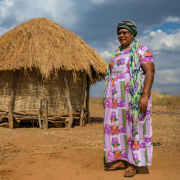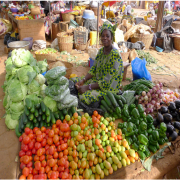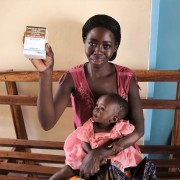Speeches Shim

The Chieftainess and her community are reaping the rewards of a USAID program that helps communities and community members document their land. The USAID Integrated Land and Resource Governance program relies on a suite of innovative technology tools (MAST) developed by USAID to affordably, efficiently, and transparently map and document land and resource rights. Community members are trained to help each farmer map their land. They walk the perimeter, marking GPS coordinates with handheld devices and record the details of owners and persons of interest. The community approves every parcel’s boundaries and ownership records and also develops a communal map. Each farmer is given a document that maps their land, includes their name, and the Chieftainess’s signature.

Abigail and Hope, aged 19 and 24 respectively, remember how life changed when their father died in 2004. Only children at the time, their family was plunged into poverty and the girls needed to help their mother make ends meet. In addition to braiding hair and selling sweets, the sisters would accompany their mother to the market to sell vegetables. At 14, Hope became pregnant and worried that her dreams of finishing her education, and being gainfully employed, may never materialize. Through a combination of their mother’s determination and their own creativity and resourcefulness, both Abigail and Hope managed to complete their high school education.

The Feed the Future Zambia Policy Strengthening Project tackles rural poverty and hunger through sound research, policy analysis, outreach, and capacity building. The project builds on the prior work of USAID’s Food Security Research Project through the Zambia Indaba Agricultural Policy Research Institute (IAPRI), a Zambia-based think tank dedicated to agricultural policy research and advocacy. The activity enables IAPRI to continue contributing evidence-based recommendations that facilitate the growth of the agricultural sector and contribute to sustainable environmental management.

Effective procurement and distribution of essential medicines and medical supplies is critical for maintaining the health of Zambia’s citizens. As part of the U.S. government’s worldwide Global Health Initiative, USAID’s Global Health Supply Chain Procurement and Supply Management (GHSC-PSM) project works to ensure an uninterrupted supply of health commodities to and within Zambia. Partnering with the Zambian Government, this activity strengthens logistics information systems and the use of data-driven decision-making, while providing reliable procurement services and technical assistance.
With an HIV prevalence rate of 12 percent, Zambia receives significant support from USAID under the U.S. President’s Emergency Plan for AIDS Relief (PEPFAR). These PEPFAR investments focus on scaling up integrated HIV prevention, care, and treatment programs, with the goal of reaching epidemic control by 2020. The EQUIP project supports the delivery of HIV/AIDS prevention and treatment services in the three northernmost provinces of Zambia. Through direct service delivery and technical assistance, EQUIP partners with Zambia’s Ministry of Health to expand treatment coverage, retain those on treatment in care, and provide biomedical prevention services.

Comment
Make a general inquiry or suggest an improvement.